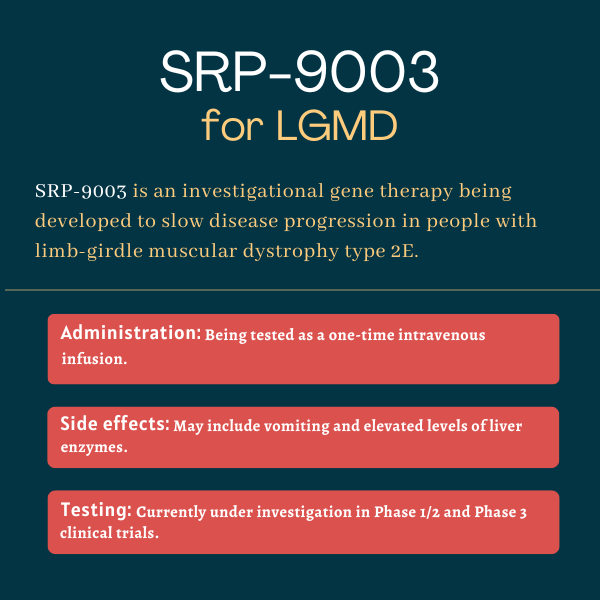SRP-9003 for limb-girdle muscular dystrophy
Last updated July 22, 2024, by Marisa Wexler, MS

What is SRP-9003 for limb-girdle muscular dystrophy?
SRP-9003 (bidridistrogene xeboparvovec) is a gene therapy candidate designed to slow disease progression in people with limb-girdle muscular dystrophy (LGMD) type 2E. It is administered via a single intravenous, or into-the-vein, infusion.
Being developed by Sarepta Therapeutics, the treatment was initially created at Nationwide Children’s Hospital in Columbus, Ohio. It was then developed by Myonexus Therapeutics under the name MYO-101. Sarepta acquired Myonexus in 2019.
The U.S. Food and Drug Administration (FDA) awarded SRP-9003 orphan drug status for the treatment of LGMD type 2E. This designation provides financial benefits, exemption from fees, and seven years of market exclusivity should the therapy be approved.
SRP-9003 also received rare pediatric disease designation from the FDA for the same indication, which grants eligibility for a priority review voucher toward a different product if SRP-9003 is approved.
Therapy snapshot
| Treatment name: | SRP-9003 |
| Administration: | One-time intravenous infusion |
| Clinical testing: | Currently being tested in a Phase 3 trial |
How does SRP-9003 work?
LGMD type 2E (LGMD2E), also known as LGMDR4, is a type of muscular dystrophy caused by a mutation in the SGCB gene that provides the instructions to make a protein called beta-sarcoglycan. Beta-sarcoglycan is part of the sarcoglycan protein complex, which is vital for muscle tissue health. This complex maintains muscle structure by binding to and stabilizing dystrophin proteins, which strengthen and protect muscle fibers.
In LGMD2E, a mutation in SGCB results in insufficient levels of functional beta-sarcoglycan. This hinders the proper formation of the sarcoglycan protein complex and interferes with the functioning of dystrophin. As a result, muscles — particularly in the shoulders and hips — weaken and waste away.
SRP-9003 aims to restore the levels of beta-sarcoglycan in muscle tissues by delivering a functional copy of the SGCB gene to skeletal muscle, heart, and diaphragm. The diaphragm is the dome-shaped muscle that plays a key role in breathing.
AAVrh74, a virus modified to be harmless and have increased affinity to these muscles, is used for the targeted delivery of the healthy gene. SRP-9003 also contains a DNA sequence that ensures the SGCB gene is specifically active in muscle cells. This muscle-specific promoter, called MHCK7, is particularly important due to its ability to strongly promote gene activity in the heart, which may be severely affected in people with LGMD2E.
How will SRP-9003 be administered in LGMD?
In clinical trials, SRP-9003 has been administered as a one-time infusion into the bloodstream. Patients receiving the therapy also were given immune-suppressing medications called corticosteroids to help reduce the risk of a problematic immune response against the therapy’s viral vector.
However, it is too early to know which dose and regimen will be used if and when SRP-9003 is ultimately approved by regulatory authorities.

SRP-9003 in clinical trials
SRP-9003 is being tested in a Phase 1/2 clinical trial (NCT03652259) involving children and adolescents with LGMD2E. A Phase 3 trial for patients ages 4 and older, called EMERGENE (NCT06246513), is also ongoing.
Phase 1/2 study
The ongoing Phase 1/2 trial is evaluating the efficacy and safety of SRP-9003 in children and adolescents, ages 4 to 15, with LGMD2E. Six patients were recruited and divided into two groups. Three children in group 1 received a low dose of SRP-9003 — 18.5 trillion vector genomes per kg of body weight (vg/kg) — and three patients in group 2 were given a higher dose of 74.1 trillion vg/kg.
The study’s main goal is to evaluate safety, and findings have so far been positive. There was one serious side effect related to SRP-9003 treatment, a case of liver inflammation (hepatitis) that required a short hospitalization.
Trial results also indicated that SRP-9003 treatment increased beta-sarcoglycan levels as intended: About two months after gene therapy treatment, average levels of this protein were 36.2% of normal in the low-dose group and 62.1% of normal in the high-dose group.
Analyses of tissue samples also showed that in the low-dose group about half of patients’ muscle fibers were producing beta-sarcoglycan. In the high-dose group, nearly three-quarters of patients’ muscle fibers were positive for the protein. Increased levels of the protein were sustained for at least two years after gene therapy.
Standardized measures of motor function, including tests of how long it took patients to walk 10 meters (about 33 feet) or get up from the floor, tended to improve in the first months with SRP-9003, and these were sustained out to two years after treatment.
At three years after gene therapy, statistical comparisons against an external group of LGMD2E patients showed motor function improvements with SRP-9003, which contrasted with a decline in the absence of treatment.
During the study, one patient died due to a traffic accident unrelated to the drug. The five living patients are continuing to undergo long-term follow-up.
Phase 3 EMERGENE trial
SRP-9003 is now being tested in a Phase 3 clinical trial called EMERGENE. The trial aims to enroll 15 people with LGMD2E, age 4 and older. The study is open to both ambulatory and nonambulatory patients in the U.S.
After six months of monitoring without treatment, all participants in the trial will be treated with a single infusion of SRP-9003. The study’s main goal is to test if the gene therapy leads to beta-sarcoglycan protein production in patients’ muscle fibers after about two months. The study also will be tracking safety plus a range of motor function measures.
Common side effects of SRP-9003
In the Phase 1/2 clinical trial, the most common side effects related to SRP-9003 were:
- vomiting
- elevated levels of the liver enzyme gamma-glutamyl transferase.
Other reported side effects included dizziness, nausea, and reduced appetite. In one patient, liver inflammation required hospitalization and was deemed a serious side effect. It was managed with appropriate supportive care.
Muscular Dystrophy News Today is strictly a news and information website about the disease. It does not provide medical advice, diagnosis, or treatment. This content is not intended to be a substitute for professional medical advice, diagnosis, or treatment. Always seek the advice of your physician or other qualified health provider with any questions you may have regarding a medical condition. Never disregard professional medical advice or delay in seeking it because of something you have read on this website.
Recent Posts
Related articles





